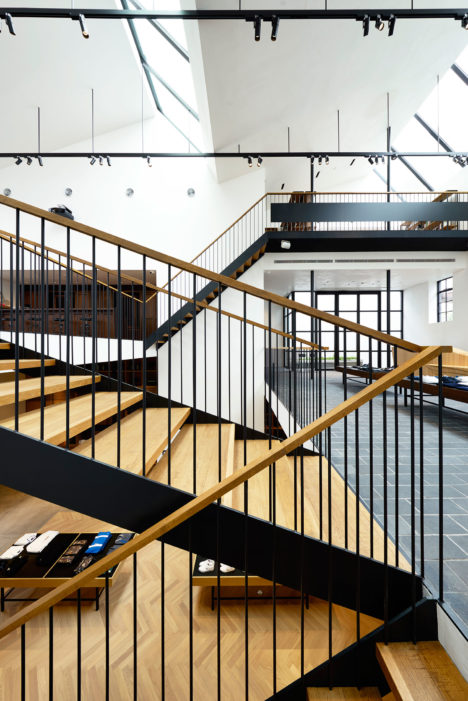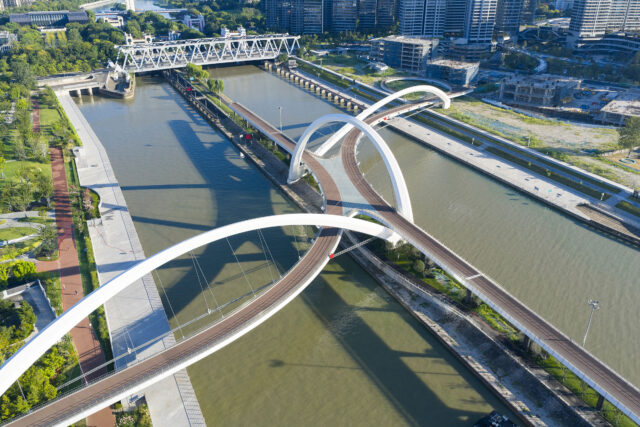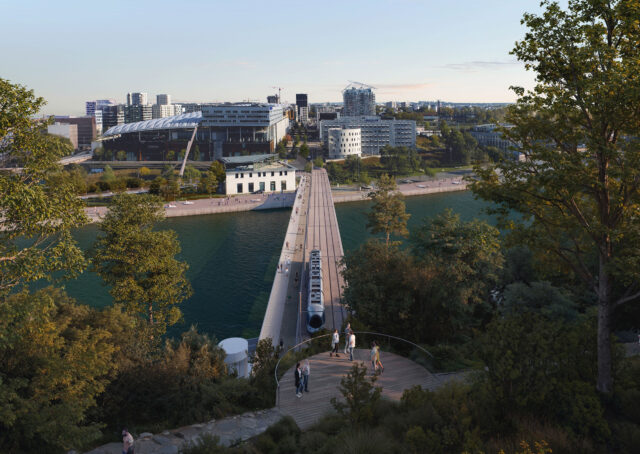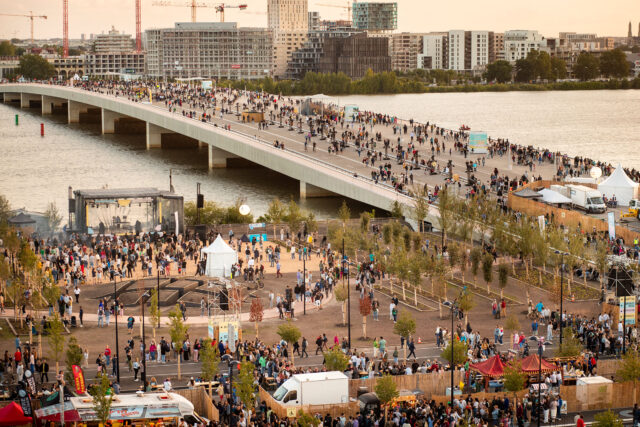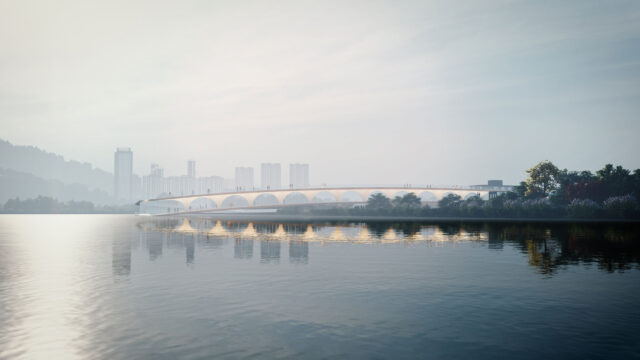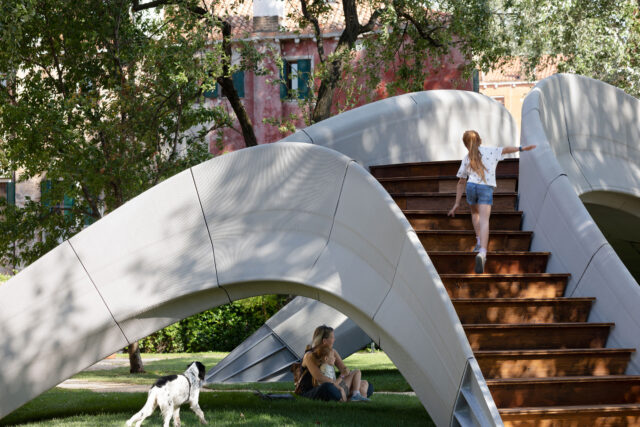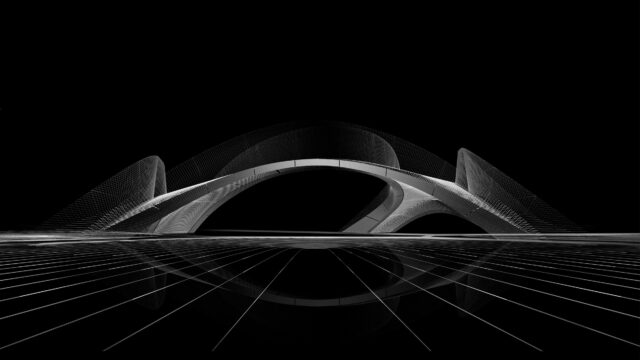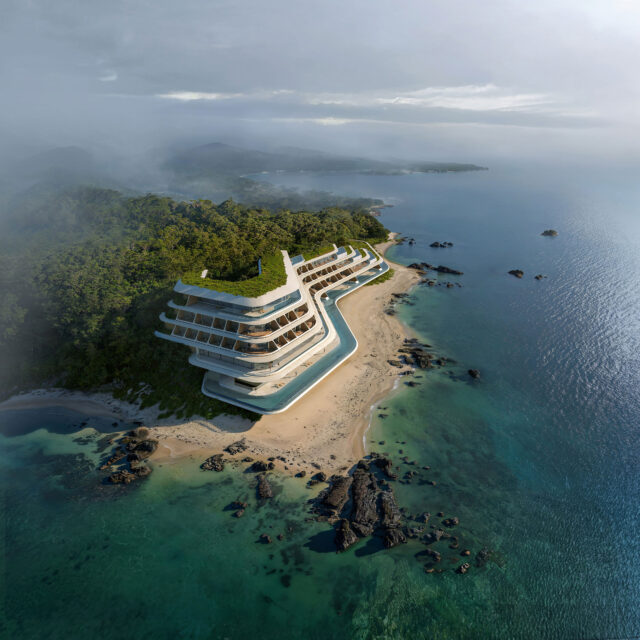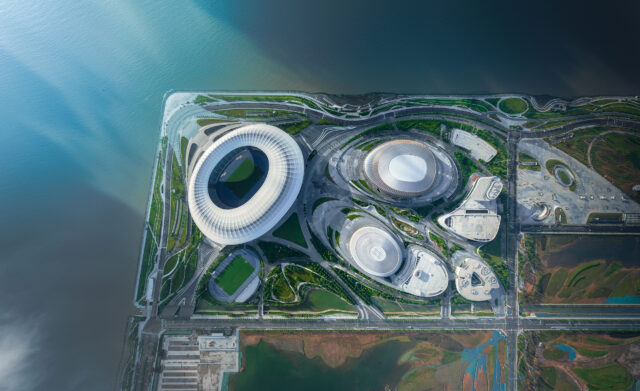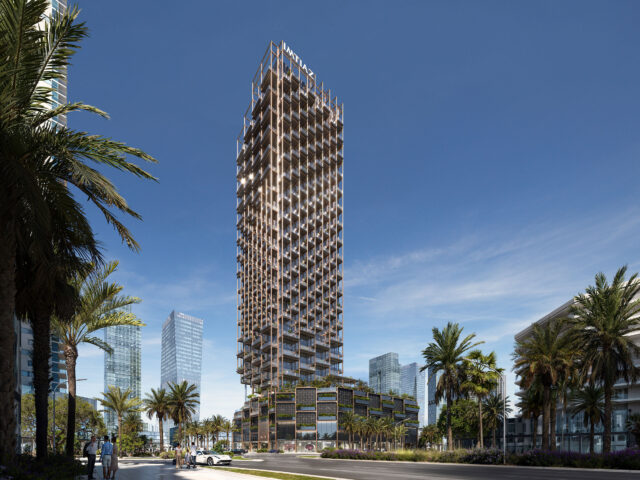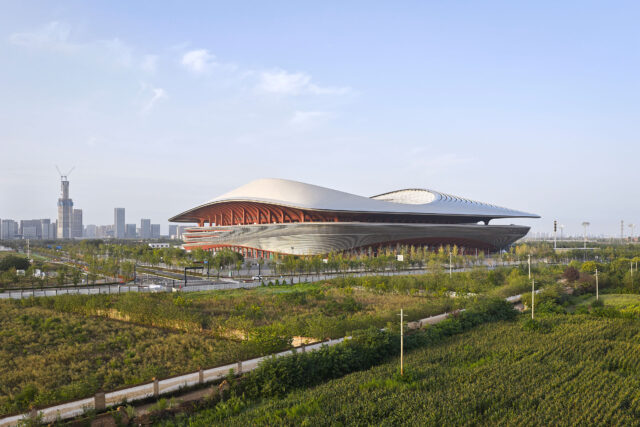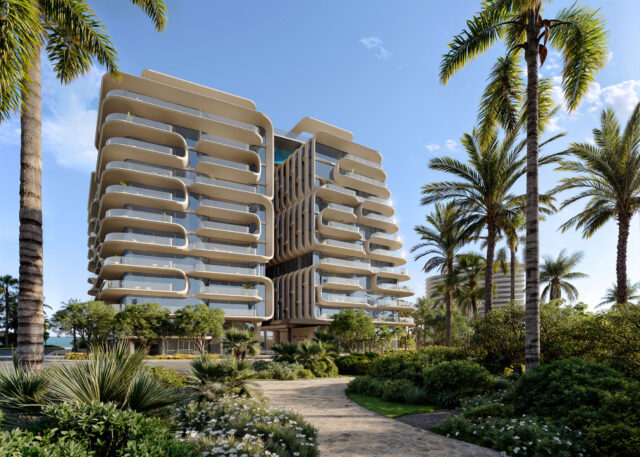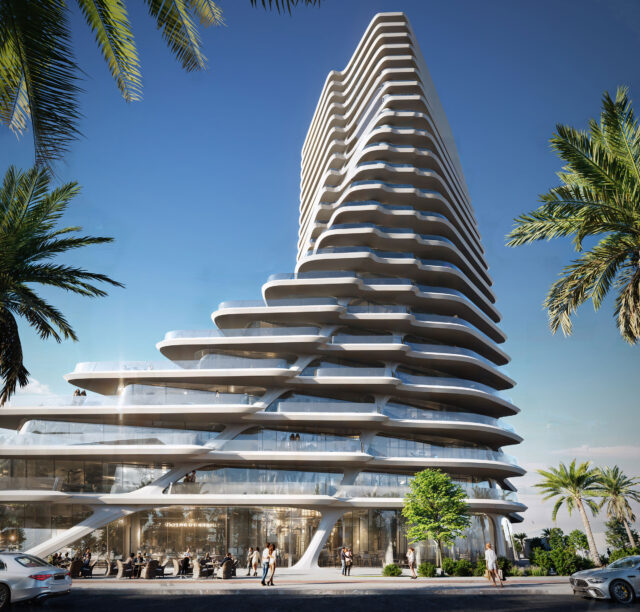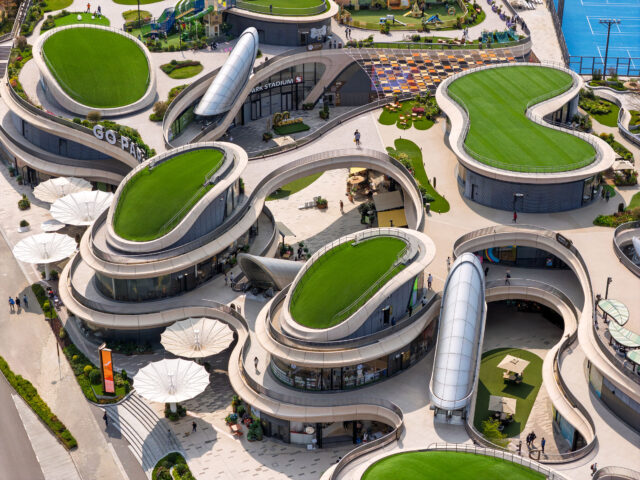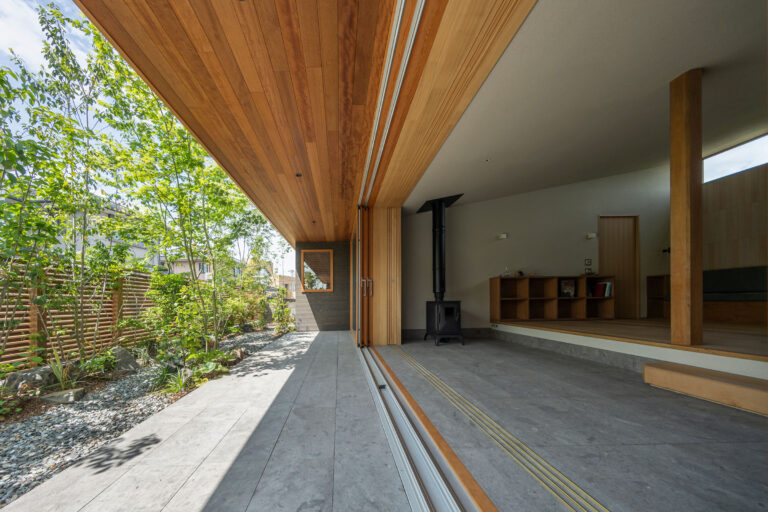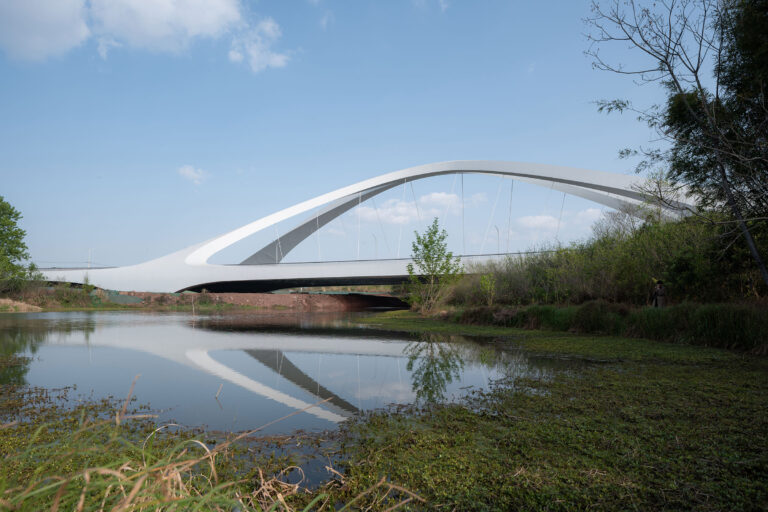
SHARE ザハ・ハディド事務所による、中国・成都市の、橋「Jiangxi River Bridge」。自動車・自転車・歩行者の為の橋の計画。全長約300mを高さ約30mのアーチで支える構造で、形状は“彫刻的なランドマーク”としても機能。構造解析で200年に1度の気象現象にも耐えうる強度も担保



ザハ・ハディド・アーキテクツが設計した、中国・成都市の、橋「Jiangxi River Bridge」です。
自動車・自転車・歩行者の為の橋の計画です。全長約300mを高さ約30mのアーチで支える構造で、形状は“彫刻的なランドマーク”としても機能します。また、構造解析で200年に1度の気象現象にも耐えうる強度も担保されました。
こちらはリリーステキストの翻訳です
成都の西線道路に架かる一連の橋の最初のものとなる全長295メートルの新しい成都西第一橋は、中国四川省の沱江の支流である江西江に架かかっています。
中央支間長185メートル、副支間長55メートル、川岸まで届く成都西第一橋梁は、蛇行する江西川に架かる道路、自転車、歩行者用の橋です。そして、西線道路が空港新都市リングロードとサイクリングルートの西側区間になることを可能にします。
アーチは120~250メートルのスパンに対して最も効率的な橋構造を提供するため、この左右対称の橋は、道路デッキの両側から立ち上がる2つの主要な鋼鉄製アーチで構成されています。上昇するにつれて、アーチは共に傾き、そのクラウンの部分で接線方向に触れ、横方向の風力から構造を安定させます。
橋を支える橋脚と橋台のダイナミックな曲率は、橋の主要なアーチと道路デッキに向かって細くなり、成都の交通インフラにおける彫刻的なランドマークとなっています。
ザハ・ハディド・アーキテクツ(ZHA)は、2019年の設計コンペに続いて橋の建設を依頼され、デザインのデジタルモデル上で構造解析ソフトウェアを使用しました。すべての材料の自重、積載荷重、交通荷重、さらに風や温度などの環境的な考慮事項を検討し、この分析によって、構造と基礎が200年に一度の気象現象に要求される基準を上回るように設計されていることが確認されました。
高さとスパンの比が約1:6であるこの橋のアーチは高さ30メートルで、道路デッキの端に沿って走る縦方向の箱桁によって基部が結ばれています。これらの繋ぎ目は、各アーチの外向きの水平推力に抵抗し、橋の基礎にかかる水平荷重を大幅に軽減します。
橋の両端にあるコンクリートの橋台には、道路デッキと西線道路の表面をつなぐコネクターが組み込まれています。江西江には基礎がないため、中間橋脚は各河岸のアーチの跳ね上がり点の下に設置されています。
この橋の埋め込み杭と橋台は、従来の現場打ち鉄筋コンクリート工法で建設されました。各アーチのスチール製ボックスセクションは、輸送と現場での組み立てのために最適な寸法でプレハブ化されました。道路デッキ内の箱桁部分の端には、ケーブル・アンカーが含まれています。これらのセクションもプレハブで、現場で溶接してつなぎ合わせるために分割して運ばれました。
橋のプレハブプレート横桁は現場に搬入され、ボルト締めカバープレートスプライス接続で端桁に接続されました。コンクリート道路デッキは、現場打ちコンクリート打設によって横桁に固定されたプレキャストパネルで構成されています。
移動式クレーンが、橋の短い組立スケジュールの中で、すべてのプレハブ鉄骨工事とプレキャストコンクリート部材を吊り上げました。西線道路の完成に伴い、江西江に架かる成都西第一橋が開通します。
以下の写真はクリックで拡大します

























以下、リリーステキストです。
The first in a series of bridges on Chengdu’s West Line Road, the new 295-metre Chengdu West First Bridge crosses the Jiangxi River, a tributary of the Tuojiang River in China’s Sichuan province.
With its 185-metre central span and 55-metre secondary spans reaching to the riverbanks, the Chengdu West First Bridge is a road, cycle and pedestrian bridge over the meandering Jiangxi River; enabling the West Line Road to become the western section of the Airport New Town ring-road and cycle route.
As arches provide the most efficient bridge structure for spans between 120-250 metres, this symmetrical bridge is composed of two primary steel arches that rise from either side of the road deck. As they rise, the arches lean together to touch tangentially at their crown, stabilising the structure from lateral wind forces.
The dynamic curvature of the bridge’s supporting piers and abutments taper into its primary arches and road deck, defining a sculptural landmark within Chengdu’s transport infrastructure.
Commissioned to build the bridge following the 2019 design competition, Zaha Hadid Architects (ZHA) used structural analysis software on the design’s digital model. Examining all material self-weight, superimposed dead load and traffic live loading, as well as environmental considerations of wind and temperature, this analysis ensured the structure and foundations have been designed to exceed the standards required for once-in-200-year weather events.
With a height to span ratio of approximately 1:6, the bridge’s arches rise to 30 metres and are tied together at their base by longitudinal box girders that run along the edge of the road deck. These ties resist the outward horizontal thrust of each arch and significantly reduce the horizontal loads on the bridge’s foundations.
Concrete abutments at either end of the bridge incorporate connectors linking the road deck to the West Line Road’s surface. With no foundations positioned in the Jiangxi River, intermediate piers are located beneath the springing points of the arches on each riverbank.
The bridge’s bored piles and abutments were constructed using conventional in-situ reinforced concrete techniques. The steel box sections of each arch were prefabricated in optimal dimensions for transportation and assembly on site. The edge box girder sections within the road deck include the cable anchorages. These sections were also prefabricated and delivered in sections to be spliced together with on-site welding.
The bridge’s prefabricated plate cross girders were delivered to the site and connected to the edge girders by a bolted cover plate splice connection. The concrete road deck has been constructed from precast panels fixed to the cross girders by in-situ concrete stich pours.
Mobile cranes lifted all prefabricated steelwork and precast concrete elements within the bridge’s short assembly schedule. The Chengdu West First Bridge crossing the Jiangxi River will open to the public on completition of the West Line Road.
■建築概要
Project Team
Client: Chengdu International Aerotropolis Group Construction and Development
Architect: Zaha Hadid Architects (ZHA)
ZHA Design: Patrik Schumacher
ZHA Project Directors: Charles Walker, Lei Zheng, Ed Gaskin
ZHA Project Architect: Han-Hsun Hsieh
ZHA Site Team: Lei Zheng, Han-Hsun Hsieh
ZHA Project Team: Jan Klaska, Lei Zheng, Marina Dimopoulou, Stratis Georgiou, Hung-Da Chien, Han-Hsun Hsieh, Martha Masli, Stella Dourtmes, Charles Walker, Ed Gaskin
───
Consultants
Executive Architect: China Southwest Architectural Design & Research Institute
Local Architect: China Southwest Architectural Design & Research Institute
Structural Engineers: Buro Happold, China Southwest Architectural Design & Research Institute
Quantity Surveyor: China Southwest Architectural Design & Research Institute
General Contractor: Sinohydro Bureau 7 Co., Ltd, China Huaxi Engineering Design and Construction
Environmental Consultant: Shenzhen Pengdaxin Energy Environmental Protection Technology
M&E Engineering: China Southwest Architectural Design & Research Institute
MEP: China Southwest Architectural Design & Research Institute
Transport Consultant: China Southwest Architectural Design & Research Institute
Fire Engineer: China Southwest Architectural Design & Research Institute
Landscape Consultant: Zaha Hadid Architects
Lighting Design: Zaha Hadid Architects
Site Supervision: China Huaxi Engineering Design and Construction

